Oakwood Cemetery Association
Cemetery Regulations
Cemetery News
Cemetery Map
Contacts
Links
Cemetery History
Oakwood Folks and Families
Family Research
Oakwood Photo Album
Friends of Nunda Cemeteries
Oakwood Sequicentennial
l865-2015
How You Can Help
Return to Main Page
|
There are probably more than five thousand individuals buried in Oakwood Cemetery. The purpose of this page is two-fold, first to provide links to any transcriptions or location resources for the cemetery's 15 sections as they become available, and to provide a place where the stories of Oakwood Folks and Families can be told. A search engine for the site is available on the main page.
If you have a transcription of any section of the cemetery, we would appreciate a copy of your work or a link to the list. We are happy to give you credit for your hard work. Families are also welcome to add your individual ancestor or family's story to this page. Please contact Tom Cook for details. |
Oakwood Folks and Families Stories
Names and dates such as those found in transcriptions and cemetery records are certainly important. But behind those inscriptions are the lives of individuals and the story of families.
Here are just some of the stories of the folks and families found in Oakwood Cemetery. Please add your own favorite story. They can come from historical research or family memories! Please send your material to oakwoodstories@nundaoakwoodcemetery.org. Contact Tom Cook if you have any questions.
Names marked with a "*" are found on their own page.
|
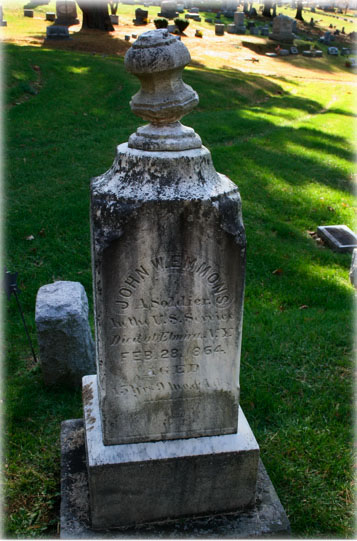 |
One of the most moving stones in Oakwood is that of John W. Emmons.
The history of the 1st New York Dragoons states that John W. Emmons was eighteen years old when enlisted into the Civil War company on January 18, 1864 in the town of Grove, Allegany County.
He wasn't. When John Emmons died of camp fever at Elmira NY six weeks later, he was only fifteen. He is one of the youngest Civil War soldiers to die in "the U.S. Service" in Western New York.
John's grave is found at the west end of OC2. In addition to his original monument, the government issued stone seen to the left is also for John Emmons.
Sources: Hand's Centennial History of Nunda; Regimental History of the 1st NY Dragoons by Bowen. Contributed by Tom Cook. Photographs by Tom Cook |
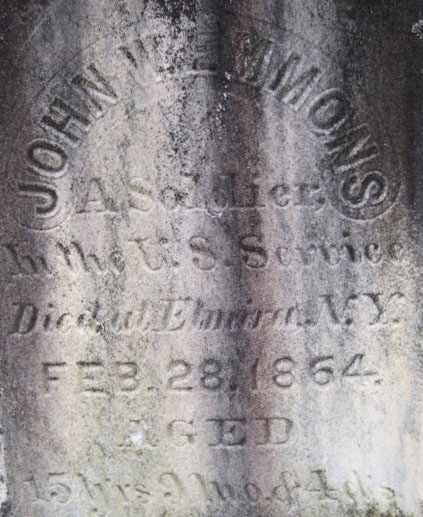 |
return to list
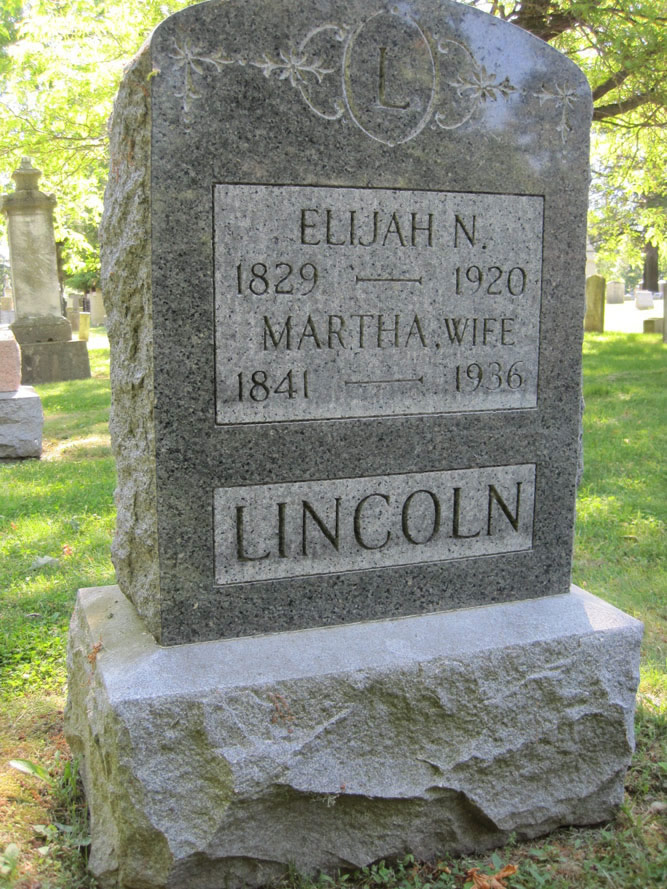 |
The Nunda News on November 19, 1920 reported that "Elijah Lincoln, who was a second cousin of Abraham Lincoln, died at his home here Tuesday night aged 89 years; he is survival by his wife. The funeral was held at the house yesterday afternoon Rev. Lowrey officiating and burial was made in Oakwood. "
Elijah was born in Vermont in 1831. (That date is from his death certificate, it is two years later from the one of the stone.) By 1850 he was listed as a farmer in the town of Pike, Wyoming County. Ten years later he was farming in Eagle, Wyoming Co, and raising a family with his wife Sarah. It is not known what happened to Sarah or his two young boys Fremont and Newall - they could not be found in the 1870 census. That year Elijah was still in Wyoming County, living with Brayton Lincoln's family in Arcade. Eventually Elijah remarried and moved with his new wife, Martha Howell, to Michigan. By 1900 the couple had returned to western New York, living on a farm north of Nunda in the town of Mt. Morris. Elijah had retired from farming and moved to Mill Street in Nunda, where he died in November 1920. His wife Martha bought the stone soon after Elijah's death for $200. Their great niece had Martha's death date added to the stone.
The Lincoln stone is found near the west end of OC2.
Sources: The Nunda News; Nunda Town Historian's Card File (on microfilm at Bell Memorial Library, Federal Census, and Rowlinson family history materials. Contributed by Lyn Rowlinson and Tom Cook. Photograph by Tom Cook
The Oakwood Cemetery Association would like to commend Lyn Rowlinson for updating the Lincoln Stone and encourage other families to complete missing dates on the markers! |
return to list
The Richmond vault, located toward the east end of OC2, is the only family vault in Oakwood Cemetery The vault actually belonged to two families; Bradford and Anna Richmond and Walter and Hannah Whitcomb.
Richmond and Whitcomb came to Nunda in 1835 to start a mercantile business in the young village. They were more than just business partners - Hannah was Bradford Richmond's sister.
Both families lost young children in the late 1830s, leading to the construction of the vault. The marble tablets which flank the entrance read "Whitcomb 1837" and "Richmond 1839." Since Bradford and Anna Richmond's first born - a son named James- died at age two in 1839, it is assumed that the young boy was laid to rest in the vault beside a Whitcomb child who had died two years earlier.
Since there is a Richmond plot behind the vault, some have speculated that most of the family's burials were outside the vault. That plot actually belongs to the Alanson Richmond family, Bradford's uncle.
The exact number of individuals entombed in the vault is not known. Since it is recorded that Hannah Richmond Whitcomb was laid to rest there in 1890, it is assumed that she joined her husband, Walter, who had died in 1880. The mortal remains of Bradford P Richmond were placed in the vault in 1898. His wife Anna may have been the last burial in the vault. She died in 1904.
When Bradford and Anna's daughter, Anna Richmond Warner, died in June of 1931, records indicate she was buried "in front of vault". This could, of course mean, that she was buried inside the vault. Her boulder shaped gravestone, see in the photograph just to the right of the vault, implies that she was buried literally "in front" of the vault's entrance
Today the vault's old iron door rests again the concrete wall that now seals the vault. The surrounding trees, planted long ago, make the vault on of the prettiest landmarks in the cemetery. |
"My Dearest Anna. Letters of the Richmond Family 1836-1898" was written by Mary Rathbone Acker in 1981. The book documents the life and times of Bradford Perez Richmond and Anna Whitwell Richmond through family letters. The photograph on the cover is Anna Whitwell Richmond taken in 1851. Historical tours of Oakwood Cemetery often include reading selections of this wonderful book at the family's vault.
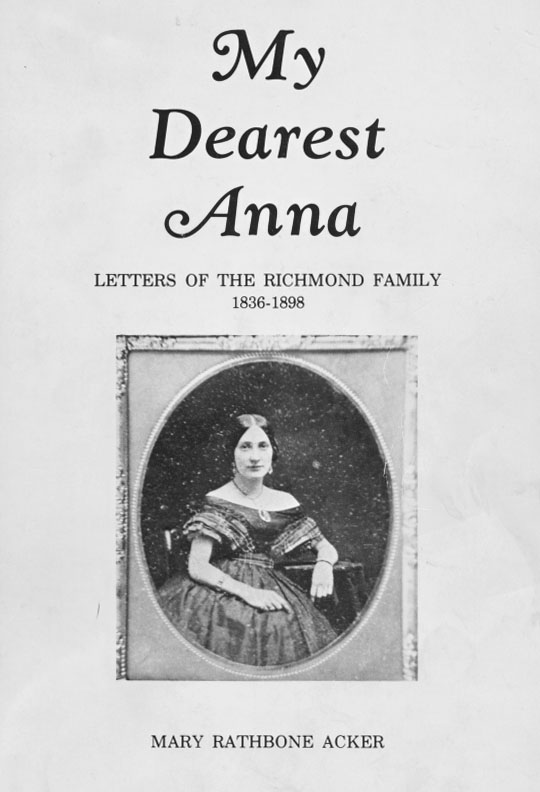 |
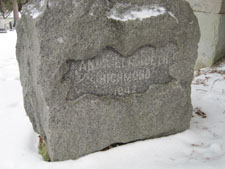
Anna Elizabeth Richmond Warner (1842-1931) was the mother of the well-known novelist Anna Warner French (1869-1913). You can see the edge of the Richmond vault to the right. Anna Warner French had visited her grandmother in Nunda many times. |
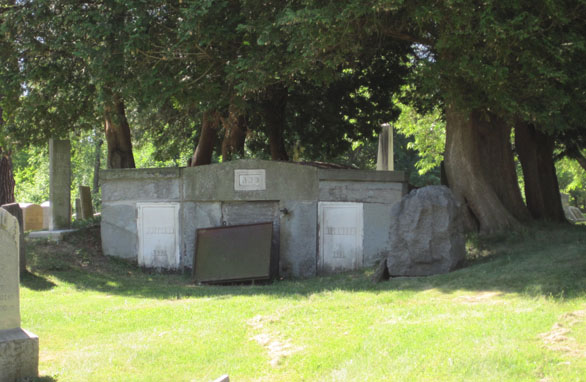
Sources: Hand's "Centennial History of Nunda"; the Nunda News; Nunda Town Historian's Card File (on microfilm at Bell Memorial Library, and "My Dearest Ann" by Mary Rathbone Acker. Contributed by Tom Cook. Photographs by Tom Cook
|
return to list
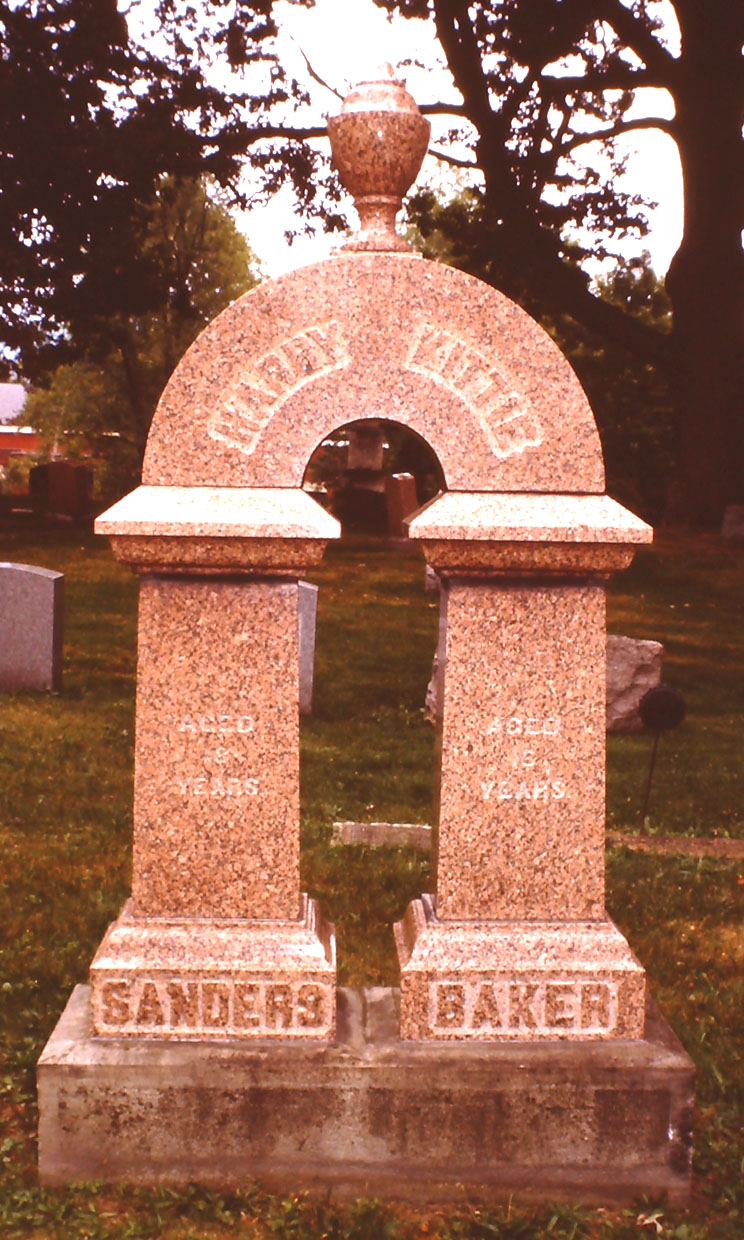
|
Harry Sanders and Kittie Baker sleep side by side beneath this poignant monument in Oakwood Cemetery.
Harry was the oldest son of local newspaper editor Chauncey Saunders. A talented musician, he won prizes for writing at Nunda Academy and showed an interest in the newspaper business.
Kittie's was the only daughter of Jonas and Amanda Baker, a local carriage maker. Described as "beautiful in personand character", she was a successful scholar at the local academy.
On July 3, 1880, Harry and Kittie, with their parents permission, joined eight other couples on an outing to nearby Silver Lake. All had a wonderful day on the water. Around 9 PM the couple decided to take one more trip across the lake. Two friends followed them in another rowboat, but turned around half way across the lake.
Harry and Kittie were never seen alive again.
Their empty rowboat was found the next morning, but several days passed before their bodies were found. It was thought that for some reason one of them had stood up in the boat, and the boat tipped, throwing them in the water. With the layers of clothing worn even for summer outings, the teenagers were unable to make it to shore.
The grieving families brought their bodies back to Nunda and buried them side by side in a plot owned by the Sanders family. Although they did not live long enough to complete their fledgling courtship, they are symbolically joined together forever by the beautiful rose colored granite monument the families erected over their graves.
You will find the Sanders/Baker Monument on the west side of Section G.
Sources: the Nunda News; Nunda Town Historian's Card File (on microfilm at Bell Memorial Library. Contributed by Tom Cook. Photograph by Jerry Barkley. |
return to list
The simple stone seen below marks the resting place of a very talented Nunda resident. Rose Shave is Nunda's most famous artist - the Nunda Historical Society has a gallery of over fifty of her works at the Historical Building. For the story of this remarkable woman, see her biography at www.nundahistory.org. Also be sure to visit the Rose Shave Gallery!
Rose sleeps with her parents and siblings in the family plot near the east end of Section I.
Sources: "Rose M. Shave, Nunda Painter" by Joan Schumaker. Contributed by Tom Cook. Photograph by Tom Cook. |
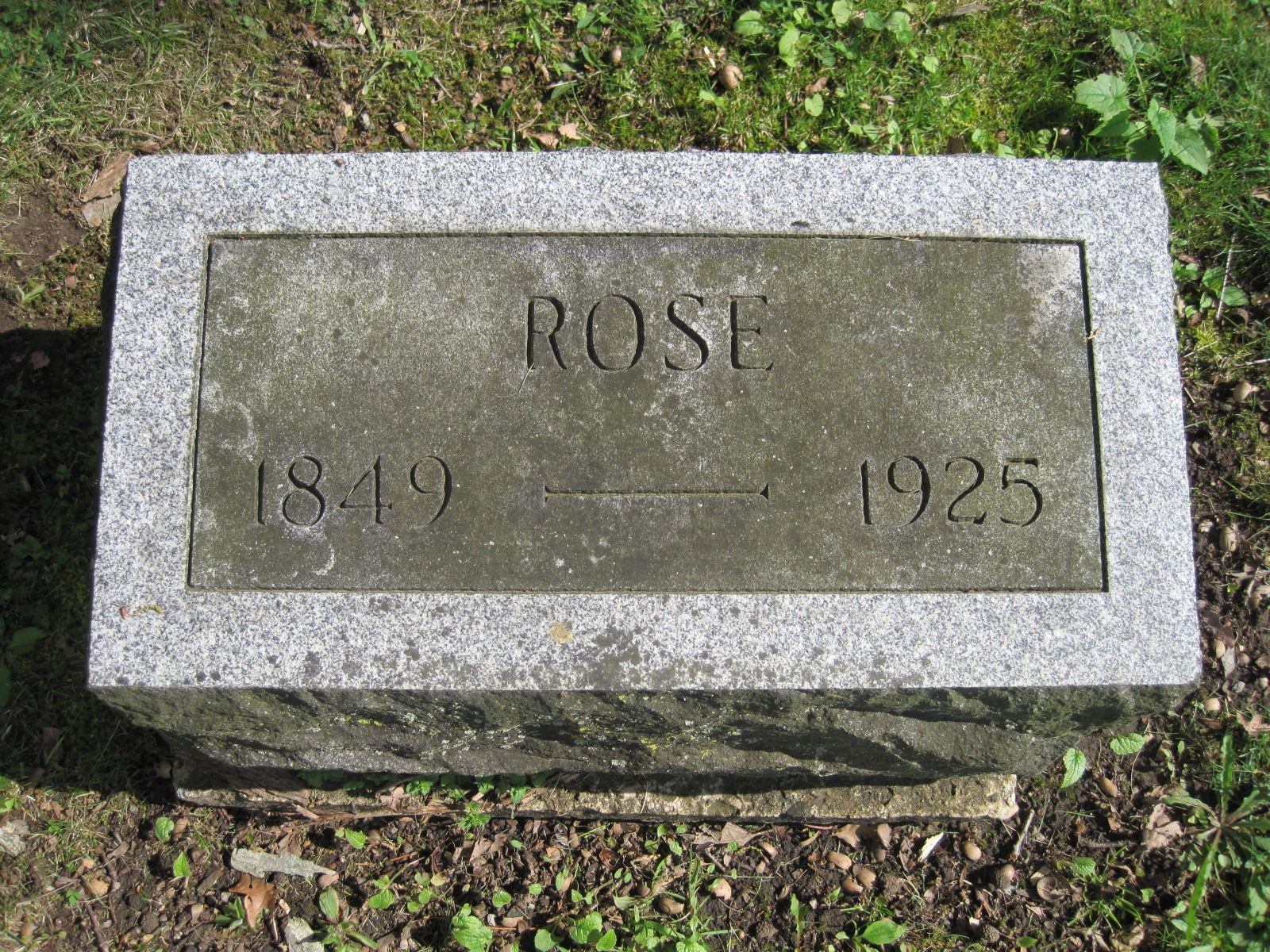 |
return to list
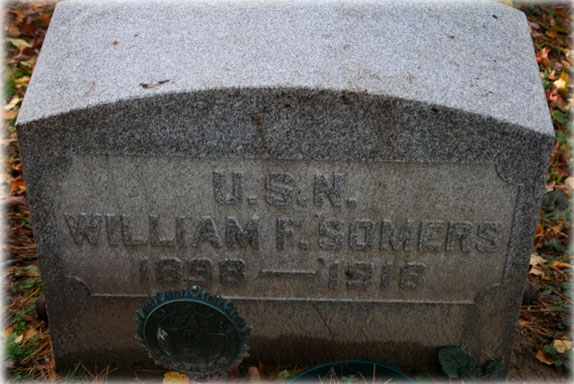
Above: The marker of William F. Somers, first Nunda area soldier to die during World War I.
Below: The gravestone of seaman Thomas J. Henry, buried a week later in Oakwood not far from Somers along the north side of OC1.
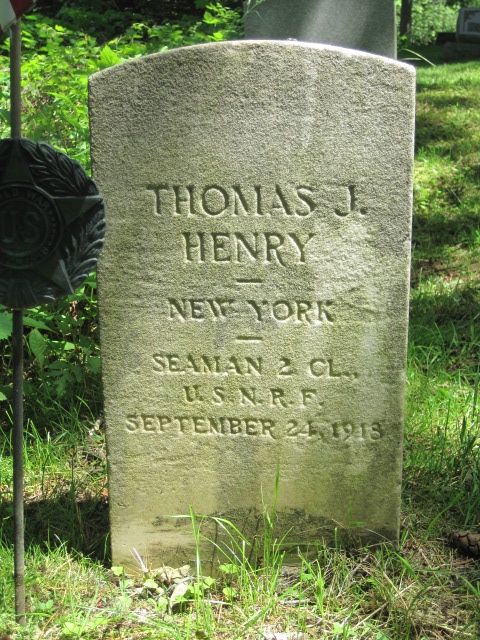 |
William Somers and Thomas Henry were the first two Nunda men to die in the service during World War I.
Somers, 20, had enlisted in the Navy in early August. He was in training at Newport when he succumbed to the pneumonia on September 21st. He was buried with full military honors in what is now the north edge of OC1 on Friday, September 27th. Somers left behind a wife, his mother, several sisters and his brother. As Nunda News editor Chauncy Sanders wrote, "Billy” Somers was a good straight boy and popular as he was big hearted; his death at the Newport hospital, after so short a time in the service of his country, lends emphasis to the fact that not all of the boys who answer the call are to return home again." By the time these words appeared in the newspaper, Nunda was preparing a second military funeral.
Thomas J. Henry, 28, was the second casualty of the "War to End All Wars.". Although he had a wife and child, he had enlisted in the Navy earlier in 1918. Stationed at the Great Lakes Training Camp, he, like William Somers, fell victim of the Spanish Influenza epidemic that was sweeping through the military and civilians alike. Henry's grave is only a few yards away from Somers.
Within a month a third Nunda sailor, Ivan DePuy was buried in Oakwood's Section C.
The obituaries of these two fallen sailors can be found at www.nundahistory.org.
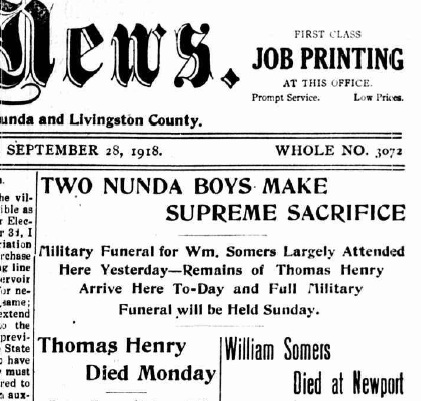
|
return to list
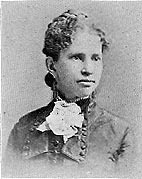
Sarah L Stilson
|
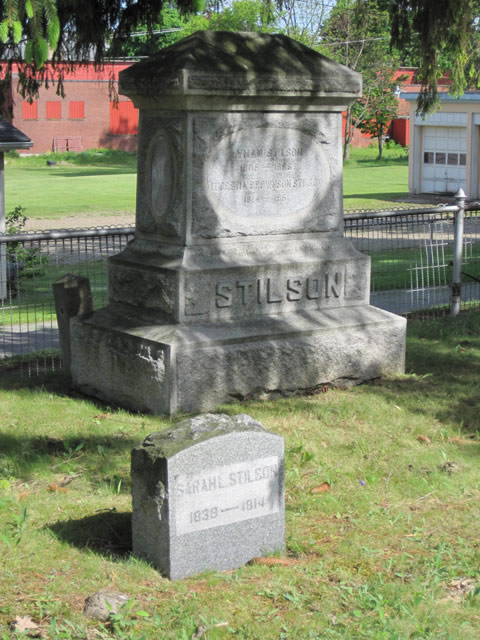 |
Sarah Stilson was born to a missionary family in Burma (modern day Myanmar) in 1838. After the death of her mother and several close encounters with robbers and tigers, the family returned to the United States and settled in Nunda. Sarah attended the Nunda Literary Institute, and taught in one of the local district schools.
Sarah went to Vassar College in 1869 and became the first female college graduate from Nunda. She taught school in Brooklyn for over thirty years, frequently Nunda, which she always considered her hometown.
Upon her retirement she spent four years traveling around the world, sightseeing, giving speeches, and collecting material for planned books and speaking tours upon her return to the States. She died in California not long after her return, and her body was brought back to her hometown for burial.
Today Sarah rests in the Stilson Plot at the east end of OC2.
Sources: Hand's Centennial History of Nunda; Nunda News; Contributed by Tom Cook. Photograph by Tom Cook |
return to list
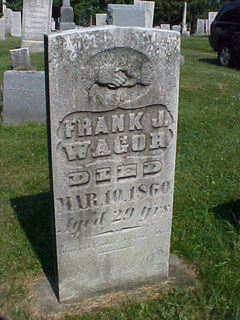 |
This beautiful stone marks the grave of Frank J. Wagor.
According to Hand's Centennial History of Nunda, "Franklin" was the eldest child of of John and Melissa Johnson Wagor. The family came from Herkimer Falls, New York. John was a carpenter and builder, and must have taught several of his sons the trade.
By 1850 young Frank(lin) was no longer living with his family. He was listed in the census as a carpenter board with another carpenter, Jacob VanWinkle.
Sometime over the next decade he married Mary Barnes. Sadly, the Nunda News of March 17, 1860 announced the death of the young man. According to J.L. Barker's diary, the funeral was held on March 12th. Frank died of "inflammation of the stomach." His grieving widow Mary was living with her parents when the federal census was taken that year. She married E.G. Richardson of Castile in 1865.
The grave is found in OC1, toward the west end. Several of his brothers and sisters, along with his father, are buried in the plot. Since one of the clasping hands seems to be more masculine than the other, they may represent the marriage of Frank and Mary. They could also symbolize an earthly farewell or earthly greeting. The epitaph reads "Dearest Frank, we miss Thee"
Sources: Federal Census 1850, 1860, Hand's Centennial History of Nunda; Nunda News; Marjorie Frost Family Index File, Bell Memorial Library; Contributed by Tom Cook .Photograph by Tom Cook. |
|



